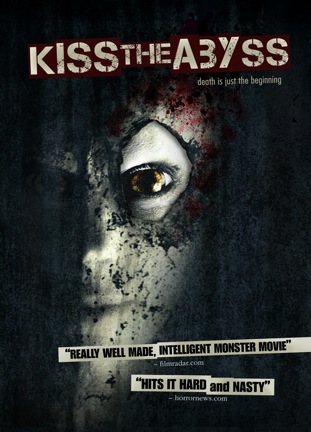Studio: Monarch Home Entertainment
Director: Ken Winkler
Writer: Ken Winkler, Eric Rucker
Producer: Eric Rucker, Scott Mitchell Nelson, Ken Winkler
Stars: Scott W. Wilson, Nicole Moore, James Mathers, Mark Craig, Douglas Bennett, Ronnie Gene Blevins
Review Score:
Summary:
Following his wife’s tragic murder, a man realizes the bloodthirsty consequences of bringing the dead back to life.
Review:
Telling the first act of its tale through flashbacks fits “Kiss the Abyss” well. Because if the story moved any slower, it would have been going backwards.
Mark and Lesley are a young couple very much in love. Noisy neighbors and making ends meet constitute their daily tribulations, but their ample affection for each other helps them get by. Until the day when their lives are shattered by Lesley’s murder. Unable to let his wife go so soon, Mark enlists the help of his condescending but well-connected father-in-law Harold to undo Lesley’s death. Harold brings Mark to a hillbilly witch doctor that claims he can bring Lesley back from the grave.
This being a horror movie, it is a safe bet that the resurrection will not go smoothly. From “The Monkey’s Paw” to “Pet Sematary,” the genre has never waffled on the idea that death cannot be undone without severe penalties. Any such attempt will most certainly result in more casualties, and usually something even worse. Alas, none of the characters in “Kiss the Abyss” have ever seen “Re-Animator,” otherwise they might now this. Unfortunately, the audience is forced to wait while the cast figures out what is already well known.
Lesley is not resurrected until almost 30 minutes into the film. Various family members finally accept the problems of her rebirth and elect to do something about it a half hour after that. This is far too long for the characters to catch up to the premise the audience knows is coming. “Pet Sematary” occupied the time with undead cats and ghosts in dolphin shorts. “Re-Animator” had headless corpses and Barbara Crampton (and another undead cat). But “Kiss the Abyss” is content with just hitting the standard beats of a resurrection gone wrong and leaving it at that.
Moving the story between those beats is a group of characters behaving predictably and stereotypically. When they are not preoccupied with shouting at or choking out each other, the white trash neighbors fill their hands with a cigarette, beer bottle, or both. A mustached henchman carries out his rich employer’s orders without question. Despite a wealthy father, Lesley and Mark live a life near the poverty level. Not only determined to make it without daddy’s help, father clearly disapproves of the boy from the wrong side of the tracks.
And just as they were unwilling to accept that Lesley died, Mark and Harold partly ignore that she has returned from the dead with a thirst for blood. Mark voluntarily wounds himself on a regular basis so his wife can feed and he employs extreme measures to help conceal her condition. Harold barely tolerated his son-in-law in the first place. Believing he is better positioned to care for a zombie, Harold uses the opportunity to deepen the rift between Mark and he by kidnapping Lesley and threatening to kill Mark.
It never makes sense when the tycoon father who condemns his daughter’s choice in husbands with questionable social status promises death for the son-in-law. Can’t the son-in-law just tell his wife, “if I die, your father did it?” Surely dad would not risk alienating his beloved daughter with the knowledge that he murdered the man she loved more than he.
The overall look of “Kiss the Abyss” is a step above homemade movie, but a step below full-fledged indie feature. It is a decent first feature for director Ken Winkler, yet it is noticeably lacking the polished sheen of a more experienced production team. Post-production ADR dialogue looping further weakens performances by giving the appearance of a 1980’s Italian giallo slasher (and not in a good way). Some scenes appear not just confined to small rooms, but to just a corner of that room. Exteriors fare better, but (presumably intentional) attempts at washed out color palettes flatten the lighting and create dull imagery to complement the dull pacing.
The “slow burn” approach can be incredibly effective for creating suspense. But a lit flame is still required. When the familiar plot is too predictable, “slow burn” ends up just being slow. And with minimal production value shown onscreen, “Kiss the Abyss” struggles to capture and maintain attention, failing to accomplish either.
Review Score: 25






Although it leaps off a compelling springboard, “The Carpenter’s Son” lands in a shallow pool in search of more commanding material.